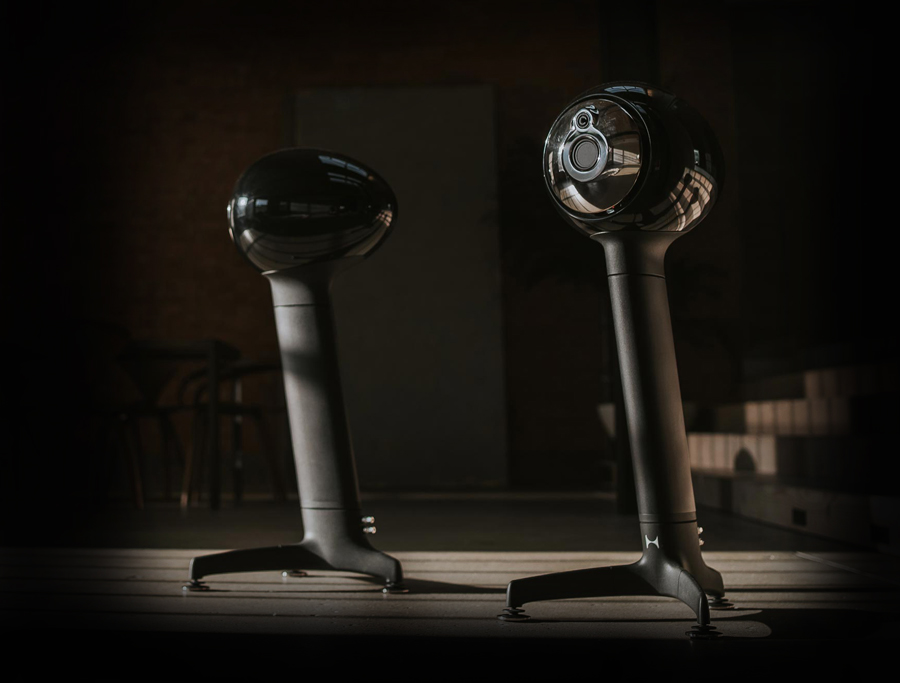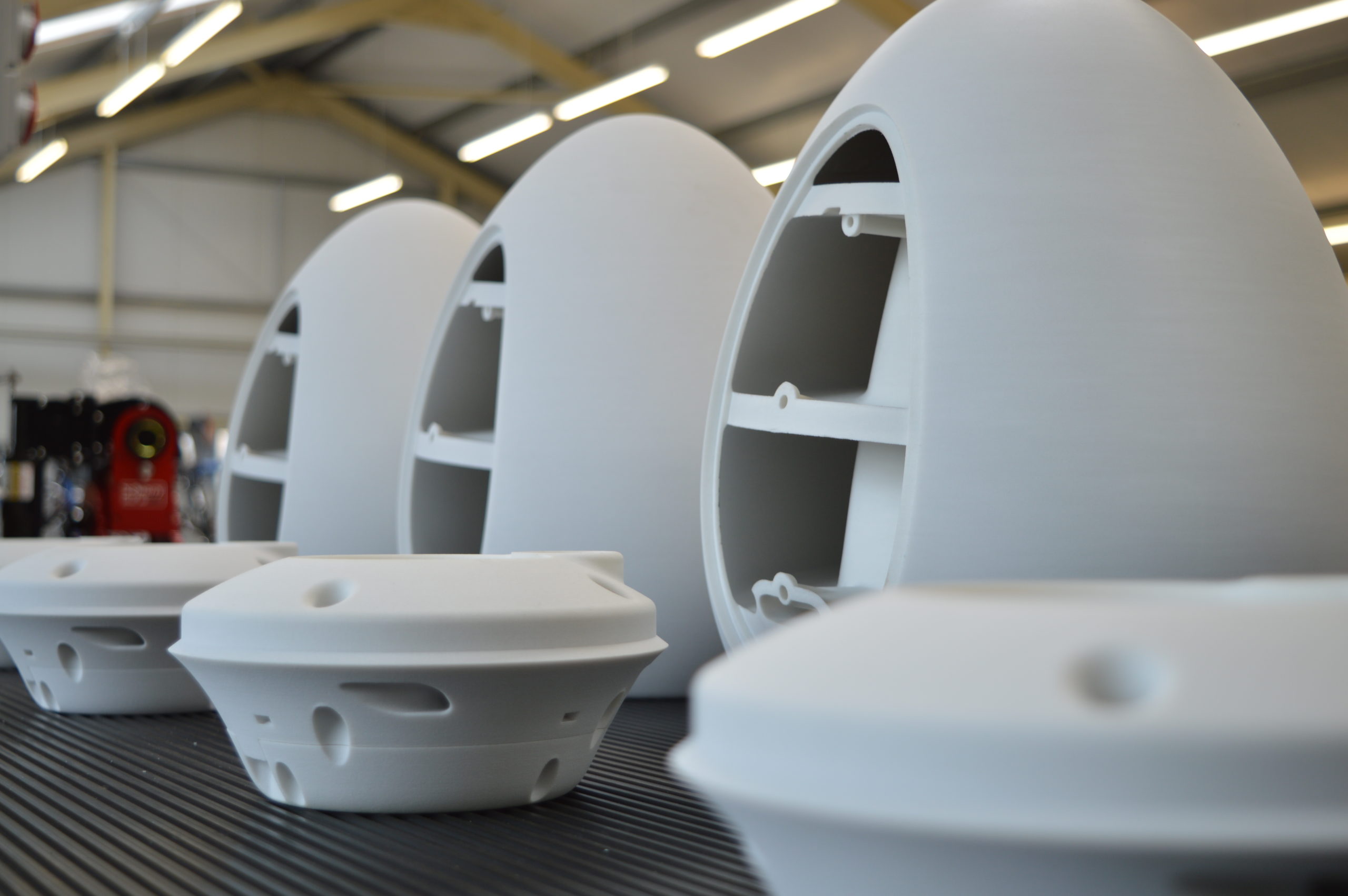Created to disrupt the HiFi industry, the 3D printed Hylixa loudspeakers look different from traditional bulky box-like models. The novel speaker’s complex geometry and cutting-edge acoustic innovation were designed and developed by Node Audio (Node) and made from glass and nylon particles thanks to advanced manufacturing techniques. Founders David Evans and Ashley May are pushing the limits of audio possibilities by exploring laser-based 3D printing technology and offering a richer sound that envelops the listener “as if the artist was in the room.”
During a special presentation of Node’s state-of-the-art facility, Evans and May provide a walkthrough of the company’s headquarters in Cambridge, UK, which have been outfitted with advanced manufacturing equipment. In the six-minute video, presented exclusively by 3DPrint.com and embedded below, viewers get to witness the entire production sequence. From the moment the first part is 3D printed to the final product, every aspect of the process has been carefully thought through and demonstrates years of research and development.
Due to its unusually innovative construction, made to mimic a human head, Hylixa speakers are designed as acoustically streamlined cabinets. The Node founders realized that, by leveraging selective laser sintering to devise the world’s first “helical bass” enclosure, they could make a small device capable of delivering a deep, rich sound. This internal helix acts as a waveguide to enhance bass performance without compromising the acoustics in other areas.

Node Audio’s Hylixa speakers manufactured with 3D printing technology. Image courtesy of Node Audio.
The patent-pending Helical Transmission Line (HTL) spirals for 1.6 meters around a conical cabinet interior. This line is fed by a dedicated bass driver and releases the sound through a circular vent around the mid and tweeter. Because the rounded cabinet is designed and manufactured as a single piece, there are no edges to produce diffraction (a disruption to sound precision). “The result is bass that is, quite literally, revolutionary,” described Node.
To optimize the speakers’ design, Node relies on 3D Systems’ sPro 60 selective laser sintering (SLS) technology, Haas VF-3SS CNC vertical machining center, Haas ST-20 Lathe (for turning the speaker cabinets back). It outsources some of the 3D printed parts for the speaker’s base to an HP Jet Fusion 5200 system.
Laser-based 3D printing technology helps drive the adoption of additive manufacturing (AM) across numerous industries by creating new product opportunities. SLS is one of the most popular polymer 3D printing techniques for industrial applications, producing end products quicker and more cost-effectively than conventional processes in some cases. According to the founders, 3D Systems’ sPro 60 SLS center makes strong parts with high thermal and chemical resistance and is the most economical thermoplastic solution for multiple parts.
Both prototyping and production of the Hylixa speakers use the 3D Systems sPro 60 SLS printer. Each of the two speakers in the set is printed separately within the printer’s 381x330x460 mm build volume, allowing complete design freedom. The cabinet and front baffle components are 3D printed as a single unified part in DuraForm GF, a glass-filled engineering nylon plastic that delivers a surface finish that is machinable and paintable and takes 45 hours to make. This decision maximizes each build, described Evans.

The team at Node maximizes each SLS build by nesting other components within the cabinet. Image courtesy of Node Audio.
As the speakers’ primary display piece, Node puts the Hylixa cabinets through a methodical post-processing regimen to remove the un-sintered powder and prepare the surfaces for whatever finishing the customer requests. The team of experts goes to great lengths to ensure that all the sintered powder is removed, especially from the inside of the speaker. But powder removal takes quite some time due to the complex geometry of the part, which means that engineers have to weigh the component against a reference and then use an endoscopic camera to ensure there is no powder in the speaker’s inner corners.
Once cleared of unsintered powder, the completed part is remarkably inert compared to rectilinear cabinets. With its high glass content, the result is an almost ceramic feel. The process leads to a fully unified cabinet and baffle, free from joins or bonding, avoiding any potential for resonance. From the lab, where the speakers are built, the part moves into the workshop, where each component is carefully measured and pair-matched.
At Node’s innovative facility, 3D printing is used beyond the speaker cabinet. Leveraging the same laser sintering process, Hylixa incorporates the first unified three-dimensional crossover. The loudspeaker’s electrical crossover network element, an electronic filter circuitry that divides up the signal coming in from the amplifier, is 3D printed with HP’s multi-jet fusion technology. The thick chassis topology is an extremely rigid cartridge design with pockets precisely built-in for the capacitors, inductors, and resistors that are populated onto the part. The technology allows Node to 3D print the wire runs as well, so the team can hardwire each component for better sound. The specialized design neatly fits into the foot of the stanchion and helps eliminate any vibration interference on the component.

Node Audio’s speakers Hylixa incorporate the first unified three-dimensional crossover, 3D printed with 3D Systems’ laser sintering process. Image courtesy of Node Audio.
The design, engineering, and manufacture are done on-site. Each cabinet and baffle assembly undergoes a manual smoothing process, painstakingly honing the surface ready for paint. From there, customers can choose from a range of paint finishes and metallic options applied by skilled paint technicians. The lacquer option is meticulously polished, ensuring a piano-level finish with absolute reflective clarity. Before being packaged, the final assembled units are acoustically measured to ensure they conform to a reference level until it receives a final ‘real world’ music test in Node’s dedicated listening room.
From a design point of view, Hylixa is optimized for exceptional acoustics. During the three years spent researching the device, Evans and Ashley decided they would break from the conventional HiFi industry and create something utterly different, without any flat surfaces. Their novel helical design “pushes out all of the horrible vibrational resonances that you get from a square cabinet,” said the founders. From the innovative vision that brings the speaker design to life to each unit’s detailed craftsmanship and complex geometry, nothing is left to chance at the facility.
Subscribe to Our Email Newsletter
Stay up-to-date on all the latest news from the 3D printing industry and receive information and offers from third party vendors.
Print Services
Upload your 3D Models and get them printed quickly and efficiently.
You May Also Like
U.S. Navy Lab Uses 3D Printing to Reduce Tooling Lead Time By Over 90%
The F-35 Lightning II Joint Program Office (JPO), responsible for life-cycle management of the key fifth-generation joint strike fighter (JSF) system used by the U.S., its allies, and its partners,...
Etsy Design Rule Change Reduces Selection of 3D Printed Goods
Online marketplace Etsy has implemented a rule change requiring all 3D printed goods on the site to be original designs. The update to the site’s Creativity Standards states, ¨Items produced using...
Honeywell Qualifies 6K Additive’s Nickel 718 for 3D Printed Aerospace & Defense Parts
6K Additive is renowned for manufacturing sustainable additive manufacturing (AM) powder, and offers a wide portfolio of premium metal and alloy powders that include titanium, copper, stainless steel, and nickel,...
MetalWorm Sells WAAM Systems to Research Institutes in Brazil and Malaysia
Turkish WAAM firm MetalWorm has sold a system in Malaysia and another in Brazil. This is an excellent example of a few emerging trends in additive. Firstly, WAAM was experimented...


































